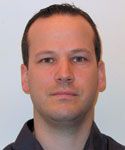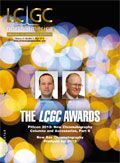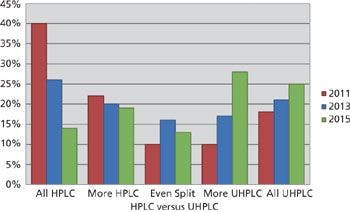Peaks of Interest
Peaks of Interest
Emily Hilder and Davy Guillarme Join LCGC's Editorial Advisory Board
LCGC is pleased to announce the additions of Emily Hilder and Davy Guillarme to its editorial advisory board.
Hilder is a professor in the School of Chemistry at the University of Tasmania (Hobart, Tasmania, Australia), where she received her PhD in analytical chemistry in 2001. She was the winner of LCGC's Emerging Leader in Chromatography award in 2012.
She is an expert in the synthesis and design of porous polymer monoliths, and new commercial monolithic separation media based on her research have been commercialized. She has two patent applications, the result of her recent work in the development of new media for dried blood spot analysis.

Emily Hilder
Hilder also has made significant contributions in ion analysis, in particular in the combination of chromatographic and electrophoretic separation mechanisms to achieve unique selectivity for ionic analytes in capillary electrochromatography (CEC). She was the first to demonstrate the mixed-mode separation of inorganic anions by CEC, including introduction of a mathematical model to describe the separation mechanism.
She was instrumental in the development of an analytical method that was identified by the U.S. Food and Drug Administration as one of the only methods suitable for screening heparin for potentially lethal impurities.
From 2004 to 2007, Hilder was an ARC Postdoctoral Fellow at the University of Tasmania. She is currently an ARC Future Fellow (2009–2013). These research fellowships recognize exceptional early- and mid-career researchers, respectively.
Hilder has more than 84 publications to her credit and has given more than 126 presentations at national and international scientific meetings.
Guillarme is a senior lecturer with the School of Pharmaceutical Sciences at the University of Geneva, University of Lausanne (Geneva, Switzerland). He earned his PhD in analytical chemistry from the University of Lyon (Lyon and Saint-Étienne, France) in 2004. He is the winner of the 2013 LCGC Emerging Leader in Chromatography award.
Areas of focus in Guillarme's work include fast and high-resolution liquid chromatography (HPLC) using state-of-the-art approaches such as ultrahigh-pressure liquid chromatography (UHPLC), core–shell technology, high mobile phase temperature, and the use of silica-based monoliths; chromatographic analysis of intact biomolecules, including therapeutic peptides, proteins, and monoclonal antibodies; hydrophilic interaction liquid chromatography (HILIC) for the analysis of polar and other ionizable compounds; evaluation of supercritical fluid chromatography (SFC) using conventional and sub-2-µm particles; and liquid chromatography coupled to mass spectrometry (LC–MS) and UHPLC–MS applied to pharmaceutical analysis.
Guillarme has made significant contributions in fast and high-resolution chromatography, comparing the different available approaches using various types of samples. He has been among the first to work and publish extensively on the possibilities offered by UHPLC, and has created an Excel calculator, available free on the University of Geneva web site, that can be used to determine the new isocratic and gradient conditions to be used when transferring a method between HPLC and UHPLC.

Davy Guillarme
A skilled public speaker, Guillarme has made 70 oral presentations at national and international scientific meetings. Guillarme has 77 peer-reviewed scientific publications to his credit, including a series of papers that discuss the possibilities of several modern widepore reversed-phase liquid chromatography phases for the analysis of large biomolecules. His work has received more than 350 citations since 2012; he has reviewed more than 120 papers for more than 10 journals and is an active reviewer for 12 journals.
Guillarme currently leads a research group at the University of Geneva. His interests in research areas include new trends in separative techniques (HPLC, SFC) and coupling with mass spectrometry; HILIC; analysis of pharmaceutical compounds; and characterization of intact biomolecules, including therapeutic peptides, proteins, and monoclonal antibodies.
Thermo Buys Life Technologies for $13.6 Billion
Thermo Fisher Scientific (Waltham, Massachusetts) will acquire Life Technologies Corporation (Carlsbad, California) under the terms of a definitive agreement signed earlier this year.
The deal is estimated to be $76.00 per share at a total cost of $13.6 billion. The transaction was reportedly approved by both of the company's board of directors, according to a press release.
Life Technologies is a global biotechnology company and is recognized as a leading player in the development of sequencing technology. The acquisition will place Thermo Fisher as a key competitor in the development of advanced genetic testing, the potential key to personalized medicine.
"We are extremely excited about this transaction because it creates the ultimate partner for our customers and significant value for our shareholders," said Marc N. Casper, president and CEO of Thermo Fisher Scientific.
Gregory T. Lucier, chairman and CEO of Life Technologies, commented, "This transaction brings together two companies intent on accelerating innovation for our customers and achieving greater success in a highly competitive global industry."
Lucier added, "This combination delivers immediate and significant cash value to our stockholders and represents a successful conclusion to the board's strategic review to enhance stockholder value and develop an even stronger future for Life Technologies."
First Institution in India Recognized by Waters Centers of Innovation Program
Waters (Milford, Massachusetts) has announced the selection of the St. John's Research Institute (SJRI, Bangalore, India) — known for its proteomics research — for its Centers of Innovation program. St. John's is the first research institution in India to join the program.
The institute is part of the St. John's Academy of Health Sciences, specifically focused on the improvement of population health. Directed by Amit Kumar Mandal, professor of molecular medicine and clinical proteomics, the center has a reputation for research into blood disorders.
Mandal, as a physical chemist interested in molecular structure, became interested in mass spectrometry in 2005 when encouraged by his professor. "The boss is always right I guess," he said. "I did an internet search and found the citation report for professor John Fenn's paper on electrospray mass spectrometry of large molecules. The citation index growth of this paper convinced everyone that electrospray mass spectrometry was an important breakthrough in science. So I gradually started learning about mass spectrometry. It's made all the difference."
Horizon Technology Donates Original SPE-DEX 4700 to Chemical Heritage Foundation
In celebration of its 20th anniversary, Horizon Technology (Salem, New Hampshire) donated an original SPE-DEX 4700 solid phase disk extraction unit to the Chemical Heritage Foundation (Philadelphia, Pennsylvania). Horizon introduced the first solid-phase extraction disk automation system 20 years ago at Pittcon 1993.
Robert Johnson, Horizon CTO and founder, and Martha Johnson, business development and founder, donated the pre-production unit of the system to the foundation archives. After the collection's committee evaluated the artifact for historical significance and fit with the foundation goals, Tom Tritton, president and CEO of the Chemical Heritage Foundation, accepted the donation.

A Novel LC–QTOF-MS DIA Method for Pesticide Quantification and Screening in Agricultural Waters
May 8th 2025Scientists from the University of Santiago de Compostela developed a liquid chromatography quadrupole time-of-flight mass spectrometry (LC–QTOF-MS) operated in data-independent acquisition (DIA) mode for pesticide quantification in agriculturally impacted waters.
Investigating 3D-Printable Stationary Phases in Liquid Chromatography
May 7th 20253D printing technology has potential in chromatography, but a major challenge is developing materials with both high porosity and robust mechanical properties. Recently, scientists compared the separation performances of eight different 3D printable stationary phases.

.png&w=3840&q=75)

.png&w=3840&q=75)



.png&w=3840&q=75)



.png&w=3840&q=75)










